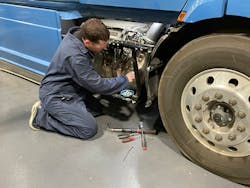An aftertreatment system failure can be a frightening prospect for a fleet’s bottom line. That’s because in the long term, the costs related to roadside service, downtime, and repairs can haunt a perfectly normal maintenance budget. In the short term, tracking down and exorcising the root cause can feel like a futile exercise in hunting ghosts. Once you think you’ve found the phantom problem—poof—it vanishes.
To truly bust the ghosts in the machines, first and foremost, technicians need a disciplined approach to troubleshooting, but it also helps to know when those efforts have reached a dead end. To help reanimate your trucks, Fleet Maintenance has communed with leading aftertreatment experts to dig up common diagnosing missteps.
Mistaken identity
Steve Hoke, president of Diesel Emissions Service (DES), sees “NOx sensors changed out all the time” to resolve an aftertreatment fault code. “But a day or week later, the truck has the same issue because replacing the sensor didn’t repair the root cause.”
The devilish DTC is summoned more often by dosing issues or a bad electrical connector in the harness, he explained.
“This does cause additional stress on both the customer and shop,” Hoke added.
An OEM-label NOx sensor runs more than $300, which isn’t so scary, but then you have to factor in labor and downtime, as well as when the shop, either in-house or external, can service the truck. One phantom problem can end up costing a fleet thousands.
“There are just so many components that have to work perfectly,” Hoke said. “Furthermore, even the best aftertreatment system relies on an engine that is running almost perfectly. There’s a lot to think about.”
Aside from the maligned NOx sensor, diesel particulate filters can also be cast in a bad light.
“The DPF always gets the blame, but rarely is to blame,” said Jeremy Anderson, VP of sales at FSX Equipment, a manufacturer of DPF, DOC, and SCR cleaning equipment.
See also: Don't distress; de-stress your diagnostic process
The hunt for upstream apparitions
What are some upstream apparitions a technician should be on the lookout for?
Don Kirkpatrick, director of reliability and uptime at Penske Truck Leasing, offered some guidance.
“At intake, there can be restricted air filters and intake side leaks that can reduce the oxygen available for the in-cylinder burn process,” Kirkpatrick said. “Within the engine itself, there are sensors and system controls. Those include wiring issues, faulty sensors and ECM, as well as failed intake components, boost control, or fuel system.”
He added this could also include failed internals, such as excessive oil consumption, an incorrect valve adjustment, compression loss, internal coolant loss, and burning coolant.
“In the seventh injector, there are sensors and system controls, clogged injector posts, and leaking or inefficient injection,” Kirkpatrick said.
You can’t forget about the EGR either.
“There can be clogged coolers and tubes, and carbon-packed sensors,” he reminded.
According to Hoke, the EGR has gained a ghastly reputation for developing hotspots and cracking. Some of that can be traced to design issues, but other causes include internal leaks and over-fueling.
Ryan Fox, owner of Fox Truck & Tractor in Canton, Ohio, said the EGR cooler is the first place he looks when a customer comes in with a DPF-related problem.
“I have come to look at EGR coolers as a maintenance item,” Fox said. “I would rather just replace one at 500,000 miles as opposed to just letting it go completely out. That coolant can ruin a diesel oxidation catalyst (DOC), which can create even bigger problems.”
Fox provides in-depth maintenance tips on his YouTube channel, Trucking & Fixing With Ryan, and other social channels.
As a general rule, technicians should always remember that the job of the aftertreatment system is to clean up what’s coming out of the engine.
“When something isn’t working properly on that engine, the aftertreatment system just can’t keep up,” said Scott Meek, diesel training manager at Diesel Laptops, a provider of diagnostic tools, repair and parts information, and technician training and support. “You end up with an aftertreatment assembly that becomes restricted. The technician troubleshoots the aftertreatment system and resolves that but never addresses the engine. They send the truck on its way, but the same issue comes up again. When it comes to solving the toughest aftertreatment issues, solving the upstream issue is the ticket.”
Night of the Living Dead DOC
The technician still has to resolve the aftertreatment failure, too. Any upstream failures can wreak havoc on the aftertreatment system, starting with the DOC and creating a domino effect.
Regarding the DOC itself, it’s difficult to know if it has failed unless there is face plugging or other visible damage. Cleaning a DOC won’t help if the catalytic coating has been compromised, which is nearly impossible to detect without sending the DOC to a lab for analysis.
“The best thing to do is think about the relationship between components and how the aftertreatment system works,” said Dave Jerman, sales director for Roadwarrior Inc., a provider of aftermarket DPFs and other aftertreatment parts.
If a vehicle is having regen issues, Jerman advises that technicians use the truck’s history as a guide.
“The vehicle’s ECM records every active regen event,” Jerman said. “Download that history and look for trends. As an average, maybe the vehicle was regenning every 200 hours or so. Then the frequency started to increase. The technician cleaned the DOC, but the frequency didn’t change. Then it’s important to look at vehicle service history to see if any upstream issues may have poisoned the DOC. If the vehicle had a blown turbo, EGR coolant leak, or bad in-cylinder injector within the 12 months preceding the DPF failure, you know the DOC has been compromised to some degree. It’s possible that the DOC isn’t dead on arrival, but it could be getting weak in the knees.”
For this very reason, Hoke said it’s important for a technician to perform a DOC efficiency test. A poisoned DOC may continue to limp along for a while. But the DPF will continue to prematurely overload with soot because the DOC isn’t doing its job correctly. DES service facilities use a diagnostic tool to perform a DOC efficiency test as well as DPF and SCR efficiency tests on every truck that comes in with an aftertreatment issue. “It only takes about 15 minutes and gives us a quick baseline of what is going on,” Hoke said.
Although cleaning a DOC will not restore a poisoned catalyst, there could be instances when cleaning is definitely a worthwhile measure. In fact, FSX Equipment’s Anderson said some fleets are making it standard practice.
“When you pull the DPF off, you may as well inspect the DOC for any damage, like cracking or pitting,” Anderson said. “If there is any face plugging, you should pull the DOC and clean it. We’re seeing a lot of fleets that are just cleaning the DOC right along with the DPF. It’s one of those things where you might as well do it while it’s accessible. Plus, it only adds a few more minutes to the process.”
Edgar Velazquez, co-owner of Brothers DPF Cleaning in Bakersfield, California, agrees. He’s a user of FSX cleaning equipment, and always encourages his customers to have their DOC cleaned. “We charge the same price to clean both the DPF and DOC,” Velazquez said. “With the DOC, we always bake it and blow it out. We bake and blow 90% of the DPFs we clean, too.
See also: Basics of passive, active, and manual regens
Downstream demons
There are also some debilitating aftertreatment issues that can arise after the DPF. Sometimes it’s something relatively simple.
For example, there could be instances when the aftertreatment components all check out fine, but the vehicle is still throwing a fault code for backpressure. Roadwarrior’s Jerman said the technician should stop and think about how the system works.
“A backpressure tube runs from the DPF port to the backpressure transducer,” Jerman explained. “Sometimes that tube springs a leak or just becomes crimped. These are the types of aftertreatment issues a diagnostic tool won’t solve for you. Diagnostic codes will help point you in the right direction, but then you have to do some work to find out what’s really causing the issue.”
That’s good advice when it comes to DEF-related issues as well. “With the DEF system, we have seen issues with sensors and system controls, as well as contamination due to the wrong fluid or non-approved mixtures being used, or just a general failure of the DEF delivery system,” Penske’s Kirkpatrick said.
Fox has run into several instances where SCR efficiency didn’t test high enough. On many of those occasions, the SCR had become face plugged with crystallized DEF due to a leaky DEF injector. “Since we have equipment that can clean an entire Detroit 1-box, we’ll get that SCR clean and help the customer save up to 75% by not having to buy a replacement,” Fox said.
Sometimes, however, the SCR has a bigger problem than crystallized DEF.
“In my mind, the toughest aftertreatment issue is low NOx conversion,” said Josh Barstow, dealer technical product and services training supervisor at Daimler Truck North America, whose brands include Detroit engines, transmissions, and aftertreatment systems. "Sometimes a DPF becomes too clogged. The system wants to regen and get to its light-off temperature, but there’s too much hydrocarbon built up in the DPF. That can cause an overtemperature code. When that happens, the SCR will likely end up failing because it has been compromised by whatever has been causing the excessive hydrocarbon buildup in the DPF.”
According to Barstow, the technician’s first step is to test the sensors. If the sensors test OK but the DPF continues plugging up, the root problem is likely upstream of the aftertreatment system. Barstow stressed the importance of following a troubleshooting guide like the one Detroit developed.
“We’ve captured every possible avenue that could result in low NOx conversion,” Barstow said. “It could be something simple like a bad sensor or something more serious like a failed SCR. The thing is, an SCR may continue working for six months to a year after an upstream problem caused DPF overtemperatures. But the SCR continues to degrade over time until it won’t convert NOx efficiently anymore and typically needs to be replaced.”
But the technician’s work isn’t done. The root cause of the excessive DPF hydrocarbon buildup and ensuing overtemperature needs to be resolved. Tools like Detroit’s Virtual Technician can help analyze fault codes to paint a historic picture of what happened.
Let’s say everything checks out with the engine. But the technician notices a long stretch of low-boost codes and DPF overtemperature codes from about six months ago. Now they can look into the vehicle’s repair history.
“If a plugged air filter was found and replaced a while back, and then the low-boost codes went away, that could pinpoint why the SCR is now starting to fail,” Barstow said. “The technician should now confirm that the current air filter is in good shape, along with making sure any other engine health issues are found and addressed to avoid a repeat problem.”
Turning techs into ghostbusters
As an independent shop owner, Fox said he needs to ensure as much diagnostics coverage as possible. That’s why he uses two diagnostic tools, Snap-on Pro-Link and Cojali Jaltest.
“I really like Jaltest for its ability to not only diagnose difficult aftertreatment issues but also provide further repair assistance,” Fox said. “When you open up a specific fault, you get a built-in troubleshooting tree. You even see actual photos of what you’re working on, not just some drawing. That helps us locate where things like sensors are and makes the repair go smoother.”
In most instances, good diagnostic technology must be supported by manual detective work. Case in point, Fox had a customer bring in a 2012 truck with the first generation of the 1-box. That unit was a pneumatic system. After cleaning the entire 1-box, which was packed full of crystallized DEF, Fox started the regen process.
“I had to keep trying because it wouldn’t pass,” Fox said. “The odd thing was that the NOx level on the outlet side was double the inlet side. That’s impossible because you can’t create more NOx than is already in the system. So I pulled the compressed air line off the metering unit and found oil inside. Working backwards, I found that the air dryer had failed a while ago. The truck owner purchased a lower-quality replacement that wasn’t providing the clean air this older 1-box needed. All of that contaminated air ended up poisoning the SCR.”
That’s a great example of how upstream issues could be lurking just about anywhere.
It’s also a reminder that solving the scariest aftertreatment issues often means finding the resolve to resist the easy way out and exorcise those accursed faults once and for all.
About the Author

Gregg Wartgow
Gregg Wartgow is a freelancer who Fleet Maintenance has relied upon for many years, writing about virtually any trucking topic. He lives in Brodhead, Wisconsin.



